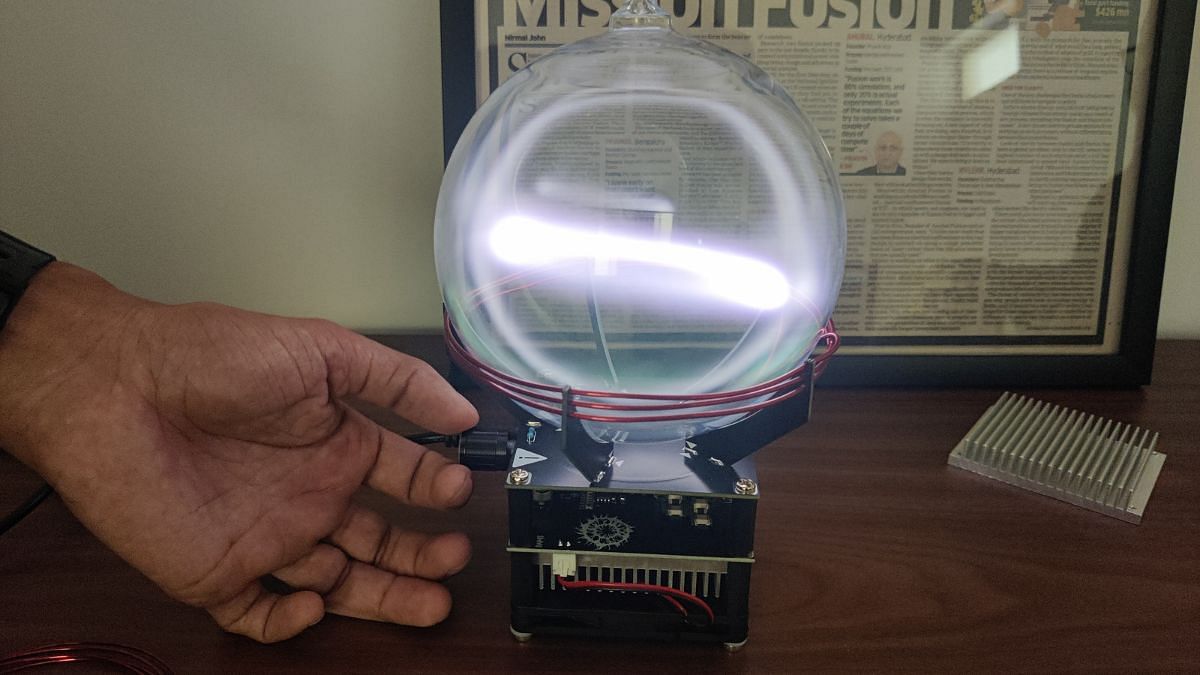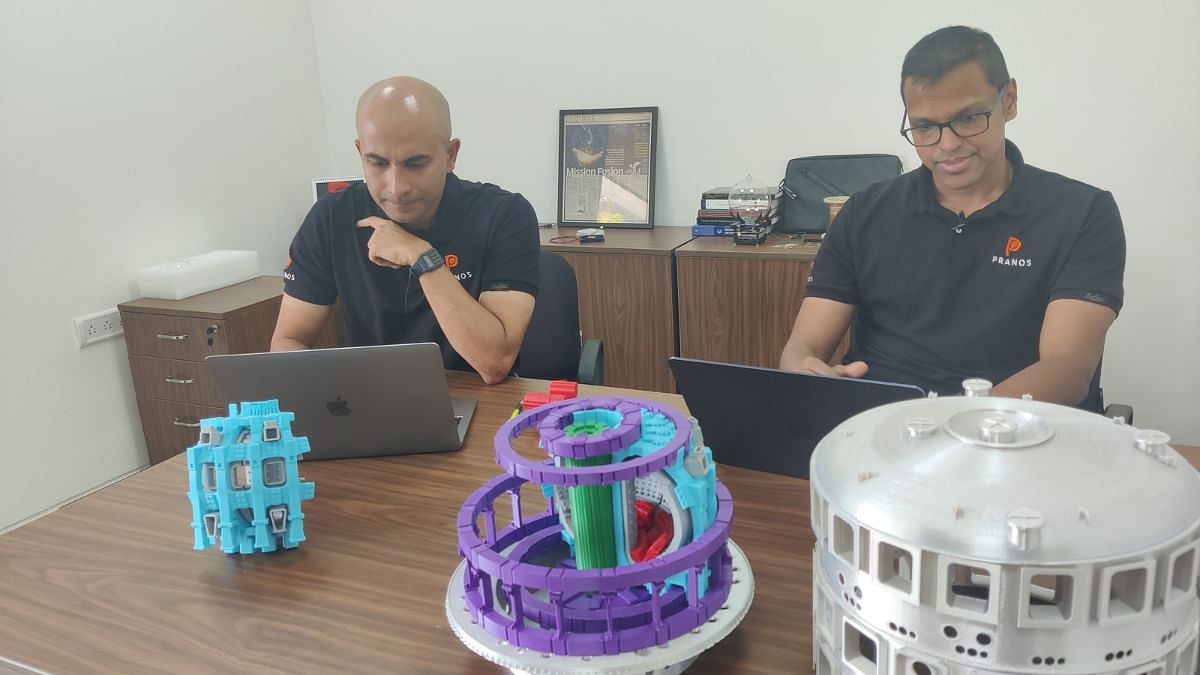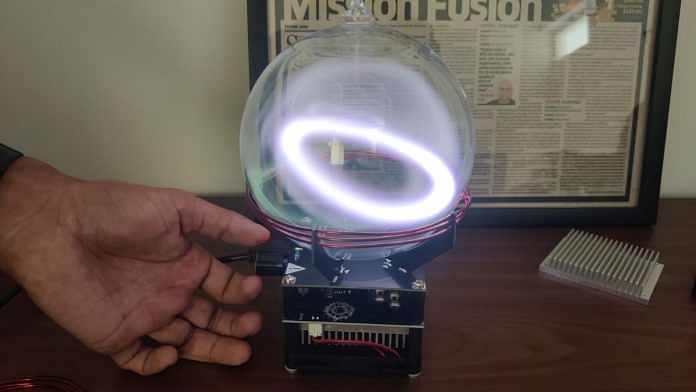Bengaluru: Shaurya Kaushal, 31, and Roshan George, 32, are like two positively-charged ions—poles apart. George is an introverted, practicing ‘yogi’. Kaushal is a hardcore Marvel fan, who enjoys a good banter. But when it comes to their life’s goal of powering India’s energy needs through nuclear fusion, they are in sync.
The result of this fusion was ‘Pranos’, one of India’s first nuclear fusion startups. The startup is all set to dig its heel into this still nascent global technology dream that promises to dramatically alter the way we produce clean energy. The world has been talking about it for four decades, but things are more urgent now with the climate clock ticking.
“I know our path for the next few years will not be easy. We are talking about a technology that is still being experimented around the world,” said Kaushal. In a black T-shirt and a pair of blue jeans, he was “unintentionally” colour-coordinated with his business partner.

“But we are also ready to be pioneers in this field,” George quickly added. “Why should India always be a follower in a new global technology space?” China and France are on their radar, especially after labs there achieved a significant milestone in nuclear fusion this year.
“Fusion science has reached an inflection point,” said Vinodh Bandaru
Researchers from China’s ‘artificial sun’ reactor maintained a sustained nuclear fusion reaction for 1,066 seconds. Just about a week later, WEST Tokamak in France broke China’s record by sustaining a plasma reaction for 1377 seconds. It’s a world record that has pumped new life into this field. As governments scramble for alternate sources of energy, the success of such experiments and the work of private players like India’s Pranos are becoming more relevant. But to develop, scale, and harness this new technology, needs the participation of both the government and private sector.
“Fusion science has reached an inflection point,” said Vinodh Bandaru, Indian Institute of Technology, Guwahati professor who won an international award for his research on the subject last year.
“This is an exciting time to be in plasma physics. Projects like the International Thermonuclear Experimental Reactor (ITER) and the Spherical Tokamak for Energy Production in the UK are proof that governments and private players across the world are now focusing and investing in this futuristic technology”.
Birth of private players
White plasma flares, trapped in a glass globe, dance to a rhythmic electromagnetic buzz in George and Kaushal’s tiny office at Bengaluru’s Jawaharlal Nehru Centre for Advanced Scientific Research (JNSCAR). Plasma is the fourth state of matter along with solids, liquid, and gas, and the globe looks like a crystal ball.

It’s how “magic happens”, said Kaushal.
This process of controlling and maintaining a stable state of the superheated plasma is what is required inside the nuclear fusion reactor. But the buzzing sound and the wavy motion in the globe is an indicator that the plasma is not stable.
The plasma globe is what adds a certain pizazz to George and Kaushal’s otherwise drab office. Pranos Fusion is just eight months old, its work is still experimental, and the founders have deliberately kept everything minimal. Marie Kondo would have been proud. The only ‘decorative item’ is a miniature model of the International Thermonuclear Experimental Reactor (ITER), a collaborative nuclear fusion research and engineering megaproject being built in France that occupies pride of place on the lone desk.

Every now and then, they get a visitor—a friend, a journalist, a potential investor, and sometimes a curious stranger who is keen to learn about their work. George and Kaushal look forward to such days to go “all nerd” about fusion.
“Fusion is what happens in the Sun. It is the biggest and the most real example of how nuclear fusion works”
“To know that there are people out there who are showing an interest in the subject and in our work, is encouraging,” said Kaushal.

But these conversations also almost always end with a cast of doubt about whether the two will be able to make headway into this breakthrough technology. George and Kaushal see this as an opportunity to prove naysayers wrong.
When Pranos grows up, they want to become the largest company to power Indian households with nuclear fusion energy. Their ultimate aim is to develop 2,500 modular fusion reactors, each with a capacity of 50 MW. If this becomes a reality, the reactors will collectively generate 3,000 GWh daily, which can power nearly 1 billion average Indian households for a day.
But they’re not the only ones plotting a future in this nascent landscape. In Hyderabad, Anubal Fusion and HYLENR are also early-stage startups looking at creating a sustained nuclear fusion reaction. In July last year, HYLENR received a patent for a low-energy reactor.
Kaushal, a computational physicist with a PhD in computational fluid dynamics, and George, a computer science engineer, started discussing a joint venture in the nuclear fusion domain in 2021. They were inspired by UK-based JET Laboratory’s record of successfully producing 12MW of electricity for five seconds through nuclear fusion. Since then, they’ve been boot-strapping their way to their goal and raised an initial seed fund through the government’s Startup India initiative.
“That was a very crucial grant that helped us start up. Other than that, we have put all our savings into making this. Family and friends also helped us build this,” said Kaushal.
After he and George began working in the field, they realised that the current policies in India around nuclear energy were still biased toward nuclear fission.
The difference between the two processes is that while heavy atoms are split into lighter atoms to produce energy in nuclear fission, in fusion, atoms are combined. This was primarily because fusion is still a considerably new technology not just in India but across the world. Achieving fission is far easier than fusion.
“Fusion is what happens in the Sun. It is the biggest and the most real example of how nuclear fusion works,” said George.
Pranos is a mirror of George and Kaushal’s opposing personalities. For the ‘yogi’ George, the name ‘Pranos’ has been a mix of the ‘pranas’ (from yoga) and ‘cosmos’. But Kaushal was only sold on the name because it sounds like Thanos—the Marvel villain who wanted to end the world.
“The difference is that I want to do something good for the world with the energy we produce,” Kaushal quickly clarified with a sheepish grin.
Work on fusion in India and the world
What’s working in Pranos’ favour is India’s commitment to nuclear energy. The government set a target of 100 GW nuclear power capacity by 2047 in this year’s Union budget.
Under the new Rs 20,000-crore Nuclear Mission, at least five indigenously designed and operational small modular reactors will likely come up by 2033.
India has also been a significant partner in international collaborations to develop a stable nuclear reactor, and was one of the 30 countries to come together for an international collaborative project on nuclear fusion—ITER. Once complete, the project is slated to become one of the largest international science facilities in the world. The reactor is expected to begin deuterium and tritium—two isotopes of Hydrogen used for producing nuclear fusion energy—fusion reactions by 2039. This has the potential to produce around 500 MW of fusion energy.
“The process is challenging to master, but it holds immense potential for a clean energy source for the future”
“Homi Bhabha envisioned India’s nuclear energy programme as a model for responsible energy development. Back then, it was met with scepticism,” Union Minister for Science and Technology and Atomic Energy Jitendra Singh told ThePrint. India’s ambitious target of 100 gigawatts of nuclear energy by 2047 aims to reduce carbon emissions by 50 per cent.
It’s an international race for power, and prestige. China has set the pace with its breakthrough this year. In the US, the Lawrence Livermore National Laboratory in California achieved a net gain in energy for the first time in 2022. According to the Fusion Device Information System—a database maintained by the International Atomic Energy Agency (IAEA)—around 160 fusion reactors in around 30 countries are currently under operation or under construction.
All these advancements have pumped a new interest in the technology, especially among the private players.
Once mastered, nuclear fusion technology has the potential to change how humanity lives by providing a limitless, sustainable and clean energy source. It can eliminate dependence on fossil fuels, decentralise energy production and make power affordable and abundant for the masses.
But first, scientists have to stabilise and contain plasma, which does not behave like a regular gas and is extremely difficult to contain.
“The process is challenging to master, but it holds immense potential for a clean energy source for the future,” Bandaru said.

Laws and regulations
“A lot is riding on India’s Nuclear Mission”
But India has to play catchup, and it has to begin with its nuclear policy and laws.
Regulations are still biased towards nuclear fission. According to researchers and industry experts, because of a lack of clarity around fusion technology, budding startups are left in the lurch.
A senior researcher at IIT-Kanpur, who did not wish to be identified, explained that nuclear fusion follows a very different process of reaction compared to fission. This calls for a separate set of regulations and a dedicated framework for managing fusion energy distinct from the current fission regulations.
In India, all nuclear energy functions are bound by the 1962 Atomic Energy Act, when any advancement in the field of fusion energy was at a nascent stage. The Act only specifically mentions fusion in passing in its section 2 (1) (a) while defining atomic energy, as “energy released from atomic nuclei as a result of any process, including fission and fusion processes.”
It’s time for a makeover.
A senior official from the government’s Department of Atomic Energy was optimistic given that there’s a lot riding on the Nuclear Mission.
“For years, research around fusion energy was limited to government labs and research institutes. Now that more private players are joining the fray and the technology itself is no longer a unicorn, we are bringing in differentiating regulations for fission and fusion,” the official said.
India’s first indigenously designed and built tokamak—a device that uses magnetic fields to confine plasma for nuclear fusion—was named ADITYA and came up in 1989. Located at the Institute of Plasma Research in Gandhinagar, it has since undergone several rounds of upgrades. This was over two decades after the last atomic laws were tweaked.
India has also achieved the Steady-State Superconducting Tokamak-1 (SST-1) and is going to begin work on SST-2 by 2027. However, nuclear fusion technology is still economically unviable.
A workable version of this technology will also require the success of several other technologies that are still in the experimental stage, including carbon removal and sequestering before it becomes a reliable option.
“Many countries have understood the future potential of fusion energy and are setting up different government departments for it. But that is yet to happen in India,” said George.
But Pranos Fusion’s founders are in it for the long haul.
“There will be other young people who would want to join this movement. We believe in this technology and there has to be someone who sets the ball rolling,” said George.
Challenges and the road ahead
If there is any frustration on slow progress—in policy and research—the two entrepreneurs don’t dwell on it. The stakes are high, and George and Kaushal are betting big.
George left behind his high-paying corporate job and Kaushal his career in academia to chase what their peers thought was the imaginary pot of gold at the end of a rainbow. Apart from building the technology itself, one of the biggest challenges that the two are facing is to convince young scientists and professionals like them to believe in nuclear fusion and its potential and to stay back in India, leaving behind their more promising collaborations with foreign companies and institutes.
But they are banking on the Nuclear Mission, government support and funds to build a robust public and private space for nuclear fusion. The more the competitors, the merrier.
“Scientists want to do science for science. They want a place that will provide them with a conducive environment. If that happens here, I am sure scientists looking for opportunities abroad, will stay back and contribute here,” said George.
(Edited by Ratan Priya)







Yes, it is something that happens in sun, but can never happen on Earth spontaneously. Fission is spontaneous on Earth, as can be seen in the case of heavy nucleus disintegrating into less massive nucleus. But the reverse process never happens automatically. The input energy in fusion reactions will always be higher than the output. Fusion-energy is the present alchemy.
Why call it a Bengaluru start-up when the Southies are all up in arms against North Indians, and abusing and harassing us? In fact, it’s a start-up founded by North Indians, just set up in Bangalore.. Just like most of the unicorns and firms set up in Bangalore: Founded by North Indians! I hope all of them wake up and move their offices to North Indian cities. You can’t live with people who don’t respect you.